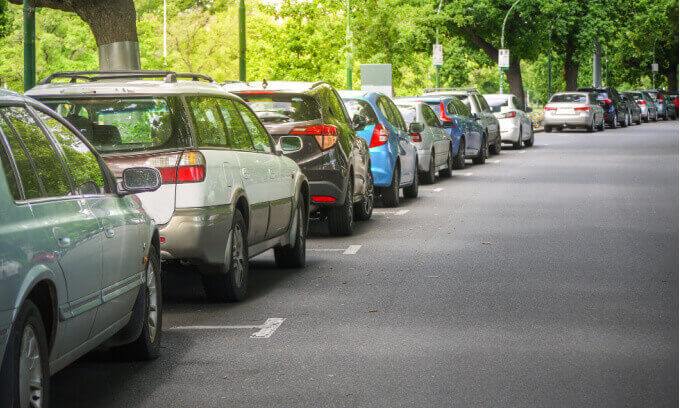KEY POINTS
- You need to transfer the registration of a car into your name within 14 days of it coming into your possession.
- Unless exempt, you will need to pay a transfer fee and motor vehicle duty.
- The cost of registering an interstate car in Victoria can vary depending on if the vehicle requires an inspection by VicRoads or a new roadworthy certificate.
If you’re buying a vehicle in Victoria, or you’ve recently moved into or out of the state, you’ll need to make sure your car is registered in your name with the correct road authority to avoid any troubles. So, you may be wondering how to transfer car registration and ownership in Victoria? We’ve put together a handy guide to help you with this process.
How to transfer registration in Victoria if you’re a buyer
When you buy a car or receive one as a gift, you will need to transfer the registration of that car into your name within 14 days of it coming into your possession, according to Victoria’s transport authority VicRoads.
You can now complete the transfer online via the myVicRoads portal, meaning you no longer need to attend in person at a VicRoads Customer Service Centre. You’ll need to request that the seller first submit an online Notice of Disposal via myVicRoads, before you log in and share your roadworthy certificate with VicRoads, and pay the transfer costs.
Buying privately
Once the seller has submitted an online Notice of Disposal, VicRoads says you’ll need to provide the following documentation to complete the registration transfer online:
- A completed vehicle transfer form—you will need to complete this with the seller and fill in the ‘buyer’s details’ section and sign. The form has been designed to guide you through the vehicle purchase to help you complete all steps correctly.
- A VicRoads customer number or Victorian licence—you will need one of these to fill in the transfer form. If you don’t have either, you will need to provide full evidence of identity documents to a VicRoads Customer Service Centre.
- An original roadworthy certificate (RWC)—the seller will need to provide this and it must be issued no more than 30 days before the date of sale. Some vehicles and transfer types don’t need a roadworthy certificate. Some exemptions include a transfer between a spouse or domestic partner to a current or former partner, or a transfer between a deceased person to a surviving spouse/partner or authorised representative.
- Payment for the transfer fee and motor vehicle duty if it applies—there are some exemptions to these fees.
Sometimes it’s not possible to transfer registration online, for example, when the seller hasn’t submitted the Notice of Disposal to your myVicRoads account or you’ve bought the vehicle on behalf of a company. In this event, you’ll need to visit a VicRoads Customer Service Centre.
Buying from a dealer
VicRoads states that when you buy a vehicle from a car dealer, it’s the dealer’s responsibility to complete the steps to transfer the vehicle into your name.
The only requirement for the buyer in this circumstance is to pay the applicable car transfer fees and motor vehicle duty (unless exempt) to the dealer and sign the vehicle transfer form. VicRoads recommends buyers keep a copy of the completed transfer form, roadworthy certificate and contract of sale.
It’s also important to note that when you transfer registration into your name, the Compulsory Third Party (CTP) insurance, which comes included under a Victorian car registration, will automatically transfer over to you as the new operator. If you’re looking at getting comprehensive car insurance and protection, you can compare providers on Canstar’s database.
- Save 15%^ on your first year’s premium when you purchase a new Car Insurance policy online.
- 24/7 Phone & Online Claims.
- Budget Direct - Insurance Solved.
- Insurance that's a bit more you-shaped.
- Canstar's 2024 Most Satisfied Customers Car Insurance - National Award.
- Lodge a Claim 24/7 with our Advisors
- Flexible cover before, 24/7 claims after.
- Save $75 on new Comprehensive car insurance online.
- Conditions apply.
- Option To Pay Monthly. Save On Your Premium By
- Increasing Your Basic Excess (Within A Given Range)*
- Lodge A Claim Online 24/7
- No age-based excess.
- No excess on your first covered windscreen repair.
- Canstar 2025 Outstanding Value Car Insurance Award.
How to transfer registration in Victoria if you’re selling
Selling privately
VicRoads notes that if you sell a Victorian registered vehicle or give one as a gift, it’s the buyer’s responsibility to notify VicRoads and to transfer the registration into their name within 14 days of taking possession. But you’ll still need to provide the buyer with the following documentation to complete this transfer:
- Roadworthy certificate (RWC), unless exempt as discussed previously. An RWC must be provided by a licensed vehicle tester.
- Vehicle transfer form (the seller must complete the ‘seller details’ section and sign).
- A copy of the registration certificate/renewal notice (to prove the right to transfer) or a myVicRoads account showing the vehicle is in your possession.
Be aware that if the buyer fails to submit the transfer and payment within 14 days, you may be liable for any traffic offences that the buyer may incur. Therefore, VicRoads suggests you protect yourself by logging into your myVicRoads personal account and submitting a Notice of Disposal for the vehicle you’re transferring as soon as it leaves your possession.
You’ll need to enter the buyer and transfer details, so make sure you record a copy during the sale, otherwise you may need to visit a customer service centre with your copy of the completed vehicle transfer form and valid evidence of identity to initiate the transfer yourself.
Selling to a car dealer
According to VicRoads, when you sell a vehicle to a car dealer, it’s the dealer’s responsibility to complete the steps to transfer the registration out of your name. All you need to do is sign the transfer form and keep a copy as proof to show the transfer was initiated.
Can you keep custom or special interest number plates if you sell your car?
If you have custom number plates and want to keep them, VicRoads states that you’ll need to notify them, cancel the vehicle registration and remove the custom plates. If you’d like to sell the vehicle registered, you’ll need to visit VicRoads, pay the fee to be issued new number plates ($41.80 at the time of writing), and attach them to the vehicle before you complete the sale. If you transfer the vehicle with your custom number plates attached, the registration rights to the custom plates will be transferred to the buyer.
How much does it cost to transfer car registration in Victoria?
When you transfer the registration of a car into your name, you may be required to pay some or all of the following fees in Victoria. Please note that the dollar figures shown here are as advised by VicRoads at the time of writing and may change in the future:
1. Registration transfer fees
When purchased privately: $44.90
When purchased through a dealer: $22.90
You can pay these VicRoads transfer fees at a VicRoads Customer Service Centre either by cash or by VISA or MasterCard (a card payment fee applies), and if sending via post you can pay by completing a credit or debit authorisation form.
Exemptions to this fee are outlined on the VicRoads website. Some exemptions include transferring from a deceased person to a surviving spouse or domestic partner, and transferring to an approved Department of Veterans’ Affairs pensioner.
2. Motor vehicle duty fees
VicRoads collects motor vehicle duty on behalf of the State Revenue Office when a vehicle is transferred to your name. According to VicRoads, the amount of duty you need to pay is based on the type of vehicle you are transferring, and its current market value at the time of the transfer.
At the time of writing, the following rates apply:
- For a passenger vehicle up to the market value of $80,567, the rate payable is $8.40 per $200 of the market value or part thereof.
- For luxury passenger vehicles valued more than $80,567.01 and up to $100,000, the rate is $10.40 per $200 of the market value or part thereof.
- For upper luxury passenger vehicles valued more than $100,000.01 up to $150,000, the rate is $14.00 per $200 of the market value or part thereof.
- For super luxury vehicles valued at more than $150,000, the rate is $18.00 per $200 of the market value or part thereof.
VicRoads indicates that when you transfer a vehicle into your name, some circumstances mean you may be exempt from paying motor vehicle duty. For example, you may be eligible for an exemption if you are transferring the registration from a deceased spouse or domestic partner into your name.
To apply for a transfer fee or motor vehicle duty exemption, you will need to indicate the exemption on the vehicle transfer form, provide any additional certified documentation needed to demonstrate your eligibility, and hand in this form and documentation at a VicRoads Service Centre.
Additional costs may also apply for the seller of a vehicle, such as the fees involved in getting a roadworthy certificate (unless exempt).
Do I still need to pay to transfer car registration to family members?
It’s possible you may need to pay fees when transferring a vehicle to/from a child or family member who is not your spouse or domestic partner. You’ll still need to notify VicRoads within 14 days of the transfer and pay the relevant fees unless the transfer meets a listed exemption.
How to change your registration when you move to Victoria
In Australia, a vehicle must be registered in the state or territory where the operator of that vehicle lives and where the vehicle is garaged (if not temporary and less than three months). So, if you have moved to Victoria from interstate, and plan to stay longer than three months, you are legally required to register your car in Victoria. The cost of registering an interstate car in Victoria varies depending upon your situation, but you may need to pay for a roadworthy certificate (if applicable), an appointment fee with VicRoads and inspection and registration fees (if applicable).
Here are the steps to register your interstate vehicle in Victoria, according to VicRoads:
1. Get a roadworthy certificate (if applicable)
You’ll need a roadworthy certificate (RWC) issued within 30 days of your registration appointment with VicRoads.
You won’t need an RWC if:
- the vehicle is currently registered interstate in your name, and going into that same name in Victoria, and
- the vehicle’s interstate registration is current, or if expired by no more than three months.
There are also other RWC exemptions regarding the type of vehicle and transfer. These are outlined on the transfer exemptions page of the VicRoads website.
2. Attend an appointment with VicRoads
Book a registration appointment with VicRoads either online, by calling 13 11 71 or by visiting a VicRoads Customer Service Centre. When booking your appointment, you’ll need to pay an appointment fee, which at the time of writing is $20.90 (card payment fees apply). Additionally, if your car needs to be inspected, you may need to pay an inspection fee.
Before making the appointment, you’ll need to know the following:
- the Vehicle Identification Number (VIN) and engine number—this can be found on the vehicle or in the vehicle handbook or by using VicRoad’s vehicle registration check (if you have the vehicle’s registration number)
- the make, model and registration number of your vehicle
- your current Victorian licence, learner permit or customer number. If you don’t have any of these, you’ll need to satisfy the evidence of identity requirements at your appointment.
Once you’ve made your appointment, you’ll need to take the following with you:
- the vehicle (if an inspection is needed),
- completed vehicle registration form,
- proof of identity,
- proof of your vehicle being registered interstate for 12 months (if advised to by VicRoads),
- a current and original Certificate of Roadworthiness (if required),
- tools and screws to put your number plates on before you leave VicRoads,
- evidence of your Victorian garage address,
- payment for registration fees.
Once you’ve registered your vehicle in Victoria, VicRoads advises you should hand in your interstate number plates at the VicRoads Customer Service Centre, so they can provide a receipt for the plates. You can keep interstate custom plates as long as you present them at VicRoads.
You’ll need to check the refund policy with the state or territory transport authority where your vehicle was registered previously to see if you can get a refund for any unused part of your interstate registration. The plate receipt from VicRoads may assist with this process.
How to change your registration when you leave Victoria
If you’re moving away from Victoria and taking your car with you, you’ll have to apply for registration in the state or territory you are moving to. When you apply for registration interstate, you’ll need to hand in your Victorian number plates and the interstate transport authority will provide you with a receipt for those plates.
According to VicRoads, you can then send this receipt along with a completed refund form to the VicRoads mailing address or visit a customer service centre and apply for a refund of the unused portion of your Victorian registration.
You can also cancel your registration and apply for a refund online via your myVicRoads account, which should be paid into your bank account within 10 business days. Make sure you take a recognisable picture of the plates after they’ve been removed. You’ll be responsible for ensuring their destruction (if applicable), so there’s no subsequent use.
If you cancel your registration in person or over the phone, make sure your address details are up to date, as any refund will be sent to your postal address by cheque within four weeks of receipt. Refunds are calculated on a pro-rata basis and an administration fee may apply. If your refund amount is less than the refund administration fees, you won’t receive a refund.
For further guidance on transferring your car’s registration or changing the registration when moving to Victoria or interstate, contact VicRoads. If you’re moving, also remember to update your details with your car insurance provider, or consider your options for insuring your vehicle within your new state or territory.
Cover image source: doublelee/Shutterstock.com








